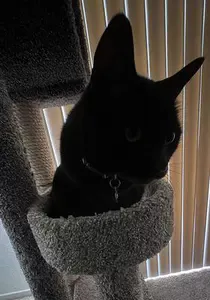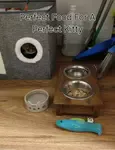What is Feline Acne?
Feline acne can affect male and female cats of all ages.
The specific causes and reasons for the development of the disease are not known. This condition is not brought on by puberty, as can be the case in humans.
A number of factors have been suggested that could be contributory, including...
- poor grooming habits
- stress
- viruses
- abnormal sebum production
- various hair and/or skin conditions
- weakened immune system
As is often the case, immunocompromised patients are predisposed, so if your cat has a condition that weakens her immune system, she's at higher risk.
Most cats are normally very diligent in their grooming habits. If your cat is not self-grooming properly, this may be a sign of other diseases as well, including emotional distress and depression.
If you notice a change in grooming behavior or your cat's coat suddenly becomes unkempt looking, call your veterinarian.
Feline acne lesions usually initially present at about 1 year of age, and may remain cyclic for the life of the cat. The lesions vary in severity, but are typically mild and asymptomatic. Pain and/or itching are not common unless there is a secondary bacterial skin infection.
Treatment may or may not be required, depending upon the severity, and any secondary conditions or underlying causes.
Sometimes, bacterial skin infections or other conditions may appear to present as acne, but are not. Depending upon their nature and severity, treatment for these conditions will vary.
Signs and Symptoms
Clinical signs of acne in cats may include...
- acne lesions on the lower lip and chin (dark brown comedones, also known as blackheads)
- crusted reddish papules (small, solid, raised areas that do not contain pus)
- pustules (oozing or draining inflamed areas)
- swelling of the chin and around the lips
Check the following link(s) for more information:
Hold the Plastic
While the exact causes of feline acne are not fully understood, many vets recommend not using plastic food and water bowls. There are two theories for not using plastic bowls.
First, it's been reported that cats using plastic food and water bowls may develop contact dermatitis or have an allergy to plastic.
Second, it's suspected that plastic may foster the growth of bacteria, and lead to acne, especially on the chin.
No matter the case, ditching plastic food and water bowls in favor of stainless steel, ceramic, or glass is recommended, as is regular and thorough cleaning of the bowls.
Cat Illness Symptoms
Cat Health
Cat Lovers Only


Comments: What do you think?
Have your say about what you just read. Leave me a comment in the box below.